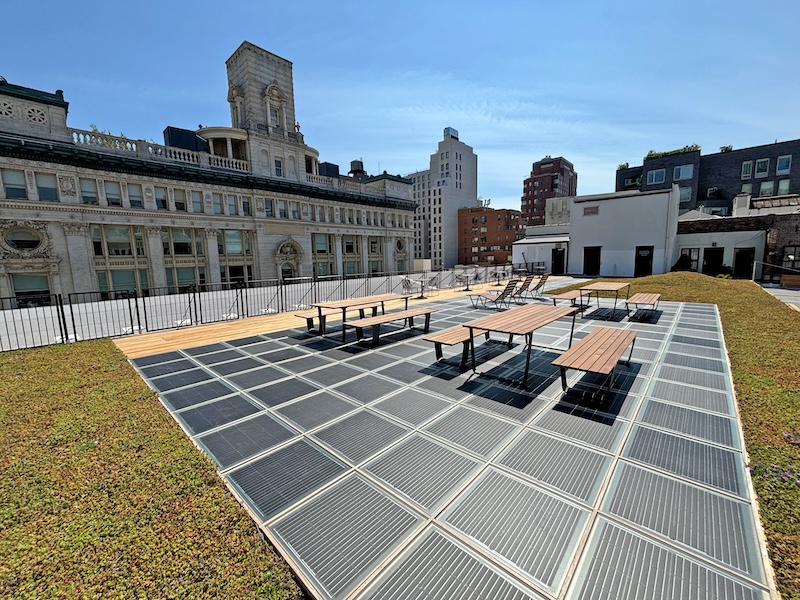Walking on Sunshine: Photovoltaic Glass Floor Revolutionizes NYC’s Urban Landscape
In New York City’s relentless pursuit of sustainability, Building-Integrated Photovoltaics (BIPV) has emerged as a transformative solution, reimagining how buildings interact with the environment. Beyond traditional façades and skylights, BIPV now extends to walkable surfaces like floors, decks and sidewalks, a groundbreaking solution that combines functionality with sustainability. Moving beyond conventional solar panels, which occupy valuable rooftop space, photovoltaic floor tiles offer walkable, safe, and visually seamless solar integration into any building’s design.
Step into the Future of Clean Energy: Photovoltaic Glass Floors
Photovoltaic glass floors represent a groundbreaking shift in solar energy integration. Unlike conventional solar panels that dominate rooftops, these floors offer a practical, walkable solution that seamlessly merges with a building’s design. BIPV floor tiles are crafted from durable materials, they withstand foot traffic while generating energy, meeting green building requirements, and maximizing rooftop usability. In cities like New York, where every square foot count, photovoltaic floors free up valuable rooftop space, transforming unused surfaces into contributors to the urban energy grid. This innovation not only enhances aesthetics but also supports compliance with Local Laws 92, 94, and 97, which mandate more sustainable, carbon-efficient building designs.
New York’s Latest Solar Innovation: 625 Avenue of the Americas
In the heart of Manhattan, 625 Avenue of the Americas exemplifies New York’s progressive energy goals, serving a dual purpose by fulfilling the city’s clean energy requirements while transforming rooftop space into an amenity that embodies sustainability and cutting-edge design. Developed and patented by Onyx Solar, a global leader in BIPV technology, and in conjunction with Solar Deck, this photovoltaic glass floor system seamlessly combines durability, aesthetics, and high-efficiency energy production. It not only meets stringent local energy standards but also elevates the building’s architectural appeal, setting a new standard for integrating renewable energy into urban spaces. Combined with a contoured green roof, the project provides a simple yet lush recreational surface.

625 Avenue of the Americas, New York
How It Works: Installation and Energy Generation
The photovoltaic floor system at 625 Avenue of the Americas is installed as a raised-access floor, allowing electrical interconnections on the backside of each panel. The tiles are supported by various substructures, including IPE wood beams, aluminum, or simple pedestal systems, providing structural integrity and flexibility in design. The energy produced contributes to the building’s power needs, offsetting energy costs in shared spaces while complying with NYC’s energy codes. The project also qualifies for incentives like the IRA 30% tax credit, making it a compelling option for both new constructions and retrofitting.
Future-Proofing Real Estate: A Sustainable Investment
Whether for new developments or retrofitting older spaces, photovoltaic floor systems offer a forward-thinking solution. In new constructions, these floors reduce overall flooring costs while generating clean energy, adding value to the property. For renovations, photovoltaic floors enhance underused spaces, increase leasable value, and attract tenants who prioritize sustainability. As demand for energy-efficient buildings continues to rise, photovoltaic floors position properties as forward-thinking investments in urban sustainability.
Global Icons Embrace Photovoltaic Floors
.jpg)
Apple Flagship, San Francisco
From the Apple Flagship Store in San Francisco to Spain’s City of Arts and Sciences in Valencia, these floors are transforming iconic spaces around the world. Now, they have arrived to commercial properties in New York City, where savvy, sustainability-focused property owners are equipping their buildings with the latest in BIPV technology.
For those aiming to reduce operational costs in shared spaces or make a significant step toward net-zero energy, photovoltaic glass floors offer customizable, scalable solutions that seamlessly integrate sustainability into the built environment.
Onyx Solar at www.onyxsolar.com












